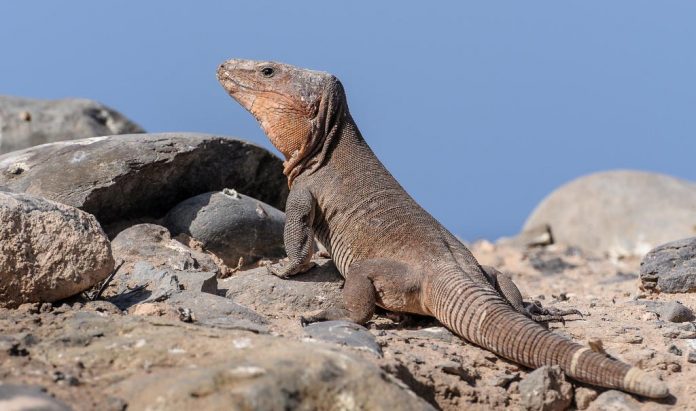She rested silently on the dry, stone wall watching me with her black eyes, studying my every move with careful precision. Her slender body soaking up every ray of the brilliant, warming sun. The long tongue flicked out of her mouth as she savoured every tasty morsel that came her way.
For a lizard, Clemmy is of diminutive size, and I am convinced that she has hardly grown over the three years that I have known her. She only appears on hot, sunny days, when the sun’s rays hit the same spot on the wall of our garden. She usually appears when I am pruning the roses, setting new plants or watering the garden.
I talk to her and she appears to listen carefully to my every word; goodness knows what the neighbours think of our conversations. Sometimes, I give Clemmy a small piece of fruit, which she enjoys, and there is always a little water dripping from a tap that needs a new washer, so I know that she does not lack liquid refreshment.
I am not an expert on lizards, so I am unsure as to what species Clemmy is, but these islands are home to some of the most impressive lizards on the planet. It is interesting to know that most of the Canary Islands have their own indigenous species and may best be regarded as a lizard paradise.
The islands of Gran Canaria, Tenerife, La Gomera, La Palma and El Hierro are home to some of the largest true lizards on the planet that can grow to around 80 centimetres long, so Clemmy has a very long way to go.
The Giant Gran Canaria Lizard (Gallotia stehleni) is a common sight all over the island if we are quiet and take care to look for them. Lizards are curious, nosey creatures that many visitors and locals simply do not see. Their disguise is superb and they can easily blend into their rocky surroundings. Fortunately, they are a protected species by law and it is illegal to catch or kill lizards.
Sadly, giant lizards are either extinct or severely endangered on the other Canary Islands, since they have been heavily hunted over the years by cats and rats and other predators. Sadly, the release of captive snakes in recent years by thoughtless pet owners has led to a reduction in the lizard population, since snakes find lizards to be a tasty addition to their diet.
The Giant Gran Canaria lizard is not to be argued with, since they have a very determined bite if provoked. Although they never attack humans, they do chase and fight their own kind. It is also true that lizards grow new tails if their original one gets damaged or bitten off by a predator.
I am reminded that 14 August is World Lizard Day, and that I have the privilege to share an island with thousands of lizards that have made the islands their home long before man became the imposter in their lives. Lizards, like Clemmy, are the true Canarians and deserve to be free and to roam as they please.
If you enjoyed this article, take a look at my websites: http://barriemahoney.com and http://thecanaryislander.com or read my latest book, ‘Living in Spain and the Canary Islands’ (ISBN: 9780995602724). Available in paperback, as well as Kindle editions.
Join me on Facebook: @barrie.mahoney
© Barrie Mahoney





